CHAPTER 13
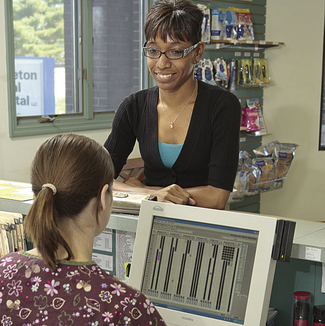
Appointment Management Systems
Mastery of the content in this chapter will enable the reader to:
• List factors that affect appointment scheduling.
• Effectively make appointments.
• Identify appointment cards.
• Discuss the importance of reminding clients of upcoming appointments.
• List methods used to increase the production and efficiency of the team by managing appointments.
• List methods used to manage clients who walk into the practice with minor emergencies.
Veterinary practices can use an appointment system or accept clients on a walk-in basis; most veterinary practices prefer appointments. A variation of both may work best for some hospitals. Appointments can help control the amount of traffic flow through the veterinary clinic at a given time. All team members should be available on days that the appointments are fully booked, whereas slower times require less staff. It is important to create a schedule that is going to keep the practice running on schedule for appointments; a client’s time is just as
valuable as the doctor’s time, and finding a medium between the two will contribute to a successful practice.
Walk-in practices allow clients to come into the clinic when it is convenient for them. However, this can decrease the efficiency of the team and prevents the regulation of traffic flow. Client wait times will increase, and team burnout will occur quickly. It is important to look at both the advantages and disadvantages of walk-ins versus appointments and decide what is best for the practice, considering both the team and the clients. The goals of an appointment system should be to maximize productivity, reduce staff tension, and control traffic flow through the veterinary hospital, all while maintaining concern for client and patient needs.
For those practices wishing to convert from a walk-in structure to appointment structure, the transition can be relatively easy. Clients are easy to train and will adapt to the new structure. A client newsletter or brochure can be sent to all clients indicating the change. The information contained in this newsletter or brochure can state the advantages to the client of the transition (Figures 13-1 and 13-2). Attractively framed posters in the reception area and exam rooms can also educate clients of the change. Once clients realize that this a better option for them, they will gladly embrace the transition.
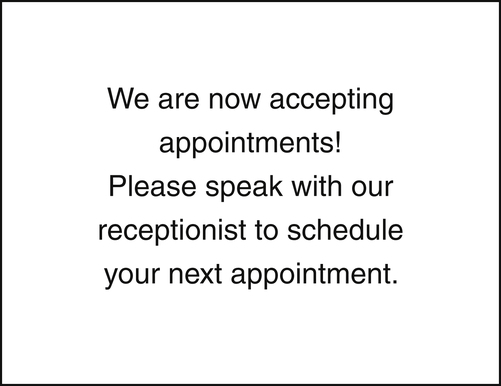
Some clinics prefer a slow transition, whereas others prefer to change immediately. Appointments can start slowly; they can be made in the mornings while walk-ins can be seen in the afternoons. This can continue for several months until appointments can be integrated into the entire day. Once appointments are scheduled throughout the day, slots can be left available for those walk-ins that have not adjusted to the change. When these clients return, they will know to make an appointment.
Those practices that integrate appointments immediately must schedule and allow for a large number of walk-ins for a short period of time. Once the clients have become trained, the amount of time set aside for walk-ins can be reduced. Walk-ins should never be turned away. If it appears that the wait time will be lengthy, team members can offer the client the opportunity to drop off the pet; the owner will be called when the patient is ready.
During the transition, team members will make mistakes; this can be a positive learning experience for all members. Teamwork, communication, and training among staff and clients will minimize the effect of these mistakes and will prevent errors from occurring in the future.
PAPER VERSUS SOFTWARE APPOINTMENT SCHEDULE
Some smaller veterinary practices have used a paper appointment schedule book with success and continue to do so. A book may work well with a one-doctor practice, but as practices continue to grow in the number of veterinarians on staff, appointment books can become difficult to manage and share when multiple clients are waiting to make appointments (Figure 13-3).
If a paper appointment book is preferred, studies indicate that a week-at-a-glance style works best. It will depend on the size of the veterinary practice as to what size of book to purchase, the number of columns, and appropriate appointment time slots. For example, a smaller one-doctor practice may use three columns per day. One column can be designated for the doctor’s appointments, one column for technician appointments, and another for surgery. A larger number of veterinarians would require more columns.
Software appointment schedulers can be accessed from any computer in the clinic, thereby allowing multiple users to make appointments. This can increase the efficiency of the staff; one team member can make a surgery appointment while another can make an appointment for a yearly exam (Figures 13-4 and 13-5). Access from multiple computers can have one disadvantage. Multiple team members may be viewing one appointment slot available, and when they click on the appointment to secure it, another team member may have already booked it. This is only a minor disadvantage compared with the number of benefits that appointment software can provide.
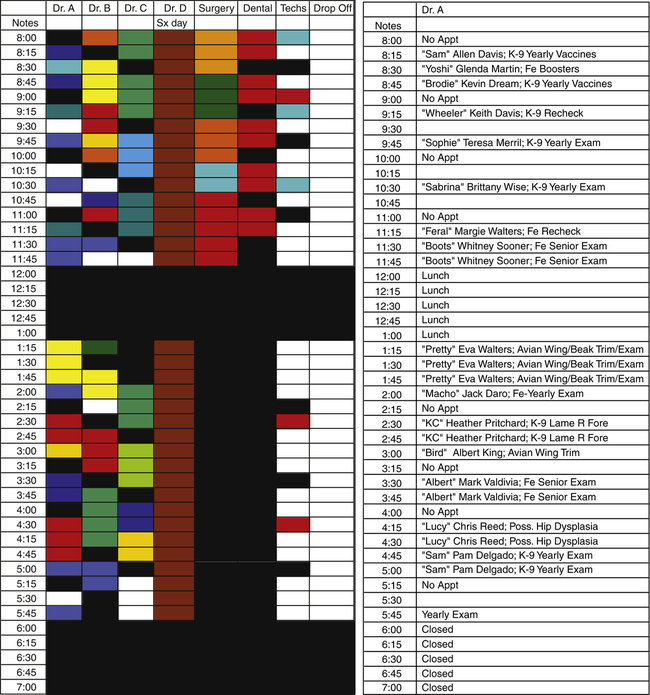

Software appointment schedulers have far more features than just scheduling appointments. When a team
member fills an appointment slot with a current client, the software can show alerts reminding the team of overdue vaccinations, tests, previous no-show appointments, or a poor credit status. When the client account is accessed, all pets owned by that client will be available, and all overdue reminders will show. This allows the reception team to either schedule an appointment for multiple patients owned by the same client or remind the owner of the overdue condition (Figure 13-6).
If a client chooses to cancel or move an appointment, software allows the receptionist to cut and paste, keeping all pertinent information together. The receptionist will not have to retype or misinterpret information.
Software allows the veterinary practice to become proactive, instead of reactive, to client needs. Proactive service begins before the client walks in the door. The client is satisfied with the ability to make an appointment, the time available, and the ability to make an appointment with the veterinarian he or she wanted to see. Reactive service is taking care of the client after he or she is upset. Perhaps the client had to wait too long, was dissatisfied with the service, or did not get to make an appointment. Appointment scheduling software can only enhance the experience of a client and make it a more pleasant experience. If the practice is technology proficient and is able to use online Web portals, clients can make their own appointments. New trends show that clients take care of personal business online and prefer to shop, search for information, and make appointments online when possible.
Every veterinary practice software program has an appointment scheduler available, which should be used to its maximum potential. Systems provided by different software companies will have both advantages and disadvantages and vary in their efficiency. Each version of software should be demonstrated before purchase. This will allow the practice to determine which software will integrate best with the practice. User friendliness and compatibility of the programs should top the list of items when looking for software. Refer to Chapter 8 for more information and guidelines on software selection for a veterinary practice.
DESIGNING THE APPOINTMENT BOOK TEMPLATE
The template is the outline of the appointment book and must be established before using a new system. Next, factors that affect appointment scheduling must be considered. The hours the clinic is open should be entered into the template first. This includes when the practice opens, closes for lunch, and closes in the evenings as well as any weekend hours. If the practice closes for weekly staff meetings, that should also be entered into the template. Holidays must be added into the system because most systems do not automatically recognize closed holidays. Permanent flex time should also be added so that employees cannot accidentally remove or book an appointment in a slot that has extra time built in. Generally, a practice manager or owner creates the template and is the only one who has access to modify it.
There are many factors that come into play when developing an appointment schedule. There is no written rule stating how many appointments should be seen or how long appointments should last. Schedules vary with each practice, and the team determines what is best for both clients and staff. Appointment layout can change as the practice grows and team members identify problems with the current schedule. Once an appointment system has been integrated, it must be aggressively managed. Appointment times, availability, length of time, and available team members should be monitored and revised on a regular basis. When developing a scheduling system, the following factors should be taken into consideration.
Number of Veterinarians
The number of veterinarians seeing appointments on a daily basis may vary. For example, if three veterinarians are seeing appointments on Monday morning, those times may be staggered so that three appointments do not show up at 9 am and overwhelm the front reception team. One appointment may be scheduled for 9 am, the second for 9:05 am, and the third for 9:10 am, for Dr. A, Dr. B, and Dr. C, respectively. If appointments are 15 minutes each, Dr. A’s next appointment will be scheduled for 9:15 am, Dr. B’s next appointment will be scheduled for 9:20 am, and Dr. C’s next appointment will be scheduled for 9:25 am (Figure 13-7).
Veterinary Technician Appointments
Some appointments can be scheduled for a technician alone, thereby leaving an appointment slot available for a producing doctor. Nail trims, suture removals, weight-management rechecks, and anal gland expressions (among many other tasks) can be scheduled with a credentialed or skilled veterinary technician (Figure 13-8). This allows veterinarians to continue to see clients who need to have a diagnosis made. Technicians can always ask a veterinarian for help if they have a question about the case.
Length of Time of Appointments
Team members must decide what length of time an appointment should be to accommodate their clients’ needs in the best way possible. Some teams feel that 10-minute slots are too short but have found them successful in increasing the overall practice profit. Thirty to forty percent of small animal practices use 15-minute slots. Time and motion studies indicate that it takes approximately 12 minutes to check in a patient, obtain a thorough history, perform a physical exam, prepare the necessary medications and client education materials, and write in the medical record. That leaves only 3 minutes
to educate the client about health issues that may be of concern. Some practitioners feel this is an inadequate amount of time to spend with their clients; however, a well-trained staff can educate the client while the veterinarian continues to the next appointment.
Other practices prefer 20-minute appointments. Some practitioners feel that they need to spend the time with the client and educate them personally, not delegate to the staff. By increasing the appointment slot to 20 minutes, the veterinarian has additional 5 minutes to educate the client. The disadvantage to 20-minute appointments is the reduction in the number of clients seen per day. On the other hand, the average client transaction can rise with the increased amount of time spent with the client. Decreased client volume per day can have a significant impact on the staff and prevent team burnout. The use of 20-minute appointment slots can also improve the practice’s on-time performance.
A 10-minute flex system is also another option for staff members scheduling appointments. Team members can analyze the client’s situation and estimate the length of time an appointment is likely to take. Staff can schedule several 10-minute blocks together to create the perfect appointment time. Each practice must decide what will benefit both the client and the team the best. Team members who schedule appointments must be knowledgeable about diseases, procedures, and clients to schedule effectively. If any question should arise regarding proper time allotment, an informed team member should be consulted; it is better to verify before making the appointment instead of overscheduling the team at a later time.
Length of Time for Client Education
Some practices schedule time for client education alone. Client education does not necessarily need to be given by a veterinarian, but should be scheduled so that clients do not have to wait. A pet may have just been diagnosed with a serious disease and the client will need to receive lengthy education regarding the patient’s disease and health. Scheduling client education can significantly increase client compliance and understanding
while establishing a lasting client-practice bond. Client education can be scheduled with a veterinary technician, allowing the veterinarian to continue seeing appointments.
Surgery
The number of operations to schedule in a day depends on the team, the length of time it takes the veterinarian to complete a procedure, and the amount of time available to complete the procedures. One veterinarian may be faster at a particular procedure and therefore able to complete more operations in a day than another. Larger practices may have two surgical tables and are therefore able to accommodate a larger number of surgical patients at a time, increasing the efficiency of the team (Figure 13-9).
Dental Procedures
Some teams may have either one or two dental tables and units available, increasing the number of dental procedures a practice can accommodate in one day (Figure 13-10). Practices can have several credentialed technicians performing dental procedures concurrently while nonsterile or sterile procedures are being completed on another table.
Nonsterile Procedures
Abscess debridement, anal sac expression, ear flushes, and patients that need to be sedated for radiographs all take time of the treatment team (Figure 13-11). Time should be allotted to complete these procedures; this will help prevent the team from backing up and running late for appointments. Clients do not see the procedures being completed in the treatment area and therefore do not perceive that the hospital is busy. They will not understand why their appointments are late. An excessive number of nonsterile procedures can increase stress on the team, preventing lunches or breaks from being taken. Proper scheduling can prevent this situation, which can ultimately lead to team burnout when it occurs on a daily basis.
Holidays
The owners and manager can decide what holidays to close for and allow the scheduler to accommodate that time off. Team members should remember that business days after a holiday closure are generally very busy and should add flex time into the appointment scheduler to accommodate minor emergencies and walk-ins that will occur.
Vacation and Continuing Education
Any time doctors or technicians take time off, it must be built into the schedule months in advance. It can be difficult and irritating to clients to have to reschedule their appointments. When the practice is short a doctor, the remaining team members must accommodate the veterinary shortage and increased traffic flow. Adjustments can be made to prevent appointments from running behind.
Type of Appointment
Appointment times can vary depending on what they are for. A yearly examination may only take 15 minutes, whereas a limping patient that requires an orthopedic exam can take 30 minutes. Team members should be aware of what types of problems are going to take longer to examine and diagnose and make adjustments when scheduling those appointments. (See Figure 13-14 for examples of appointment units and length of time.)
Appointments for new patients may take more time than appointments for existing patients; new clients may take 30 minutes instead of the usual 15 minutes allotted for existing clients.
Clients
Certain clients will always take longer than others simply because of who they are. Team members should be able to identify these clients right away and add extra time for their appointments. These clients may be in the top 10% of the practice’s producing clients, or they may like to chat. Whatever the reason, by accommodating these clients, team members can prevent appointments from running behind.
The benefit of appointment software is the ability to create an individual appointment setting for each doctor. If Dr. A prefers 20-minute appointment slots and can complete surgical procedures at a moderately quick pace, then the schedule can accommodate that change. If Dr. B prefers 15-minute appointments but is slower at completing surgical procedures, the software should be able to adjust for that.
A clinic will learn what works best for that individual practice and can make changes along the way. Word of mouth spreads quickly as clients say, “Oh, I have to go to the vet today; you know they will be running late.” It is better to hear, “My veterinarian is always on time. It is rare that I have to wait more than 5 or 10 minutes for my appointment.” However, all practices should be able to accommodate the possibility of emergencies and walk-ins. Clients may feel their pets have an emergency regardless of whether it is only an ear infection. It is important to remember client perception; they do not know what is and is not an emergency.
SCHEDULING FOR PRODUCTIVITY
Doctors should be able to delegate tasks to a well-trained staff member to continue seeing appointments and increase their productivity. If diagnostic work has been advised, the patient should be turned over to the lead technician, who can then complete the tests that the veterinarian has advised. Once results are available, the doctor can be notified and a treatment plan instituted. To keep appointments running as scheduled, the team may ask clients to wait in the reception area while laboratory work is being performed. This allows the exam room to be freed for the next appointment, preventing a 20- or 30-minute delay.
ADAPTING THE SCHEDULE FOR EMERGENCIES
Emergencies will always occur. If appointments are scheduled and emergencies arrive, it must be communicated to clients that there has been an emergency. Most clients understand the need to attend to the emergency and do not mind the wait. However, clients should be updated every 5 minutes to let them know they have not been forgotten. The team can offer the waiting client water, coffee, and/or a magazine to try to offset the wait. Remember, 5 minutes seems like 10 minutes to a client!
If an emergency arrives and it is apparent it is going to take more than a few minutes (e.g., the patient needs to go to surgery), reception members can call appointments scheduled for the day and explain that there has been an emergency causing appointments to fall behind. Team members can politely ask to reschedule appointments for a later time in the day or for another day if that does not work with the client’s schedule. Yearly exams should always be asked first to reschedule because that appointment has less priority over a client who has a sick pet.
HABITUALLY LATE CLIENTS
There will always be clients who are late. Practices may post a sign indicating that any client who is more than 15 minutes late will be considered a walk-in; they can either be rescheduled or treated as a walk-in and seen as time
permits. To enforce this policy, however, practice appointments should run on time or clients will become irate.
Once a client has been denied an appointment because of tardiness, it is unlikely he or she will be late for the following appointment. Clients can be politely addressed regarding their constant tardiness. When Mr. Derk, a habitually late client, calls to make an appointment, team members may say “Mr. Derk, the nature of Fluffy’s appointment requires the full time allotted for your appointment. Please remember your appointment is set for Tuesday, June 5, at 3 pm.” This lets the client know that your practice has recognized his tardiness in the past and will be expecting him to arrive on time.
If a client calls ahead and lets the team know he or she will be late, the receptionist should check the schedule to make sure the client can still be accommodated without delaying the rest of the appointments. If it will be a tight squeeze, the appointment can be rescheduled.
MANAGEMENT DURING BUSY TIMES
Managers can determine the busiest time of a practice. This may be in the morning as patients scheduled for surgery are being checked in along with appointments that are to be seen by associate doctors. The busy time for another practice may be in the afternoon as clients are picking up patients, walk-ins arrive, and appointments are scheduled. Whichever the case may be, the appointment schedule can be modified to alleviate the busy time.
MANAGEMENT OF WALK-INS
A veterinary practice is always going to have walk-ins regardless of an appointment policy. The client perception must be recognized as a part of good customer service. Therefore planning for these walk-ins can alleviate the stress associated with them. Time should be allotted in the scheduler for one or two walk-ins per hour, per veterinarian. Appointments should always be assured that they will be seen first, and walk-in clients must be advised that there will be a wait, but the team will do their best to get them in as efficiently as possible.
Practices can also hold appointments until the “day of.” Appointments that were previously blocked off are made available that day. This allows clients with minor emergencies and walk-ins to be accommodated without having a significant impact on appointments.
Walk-ins set the appointments behind because they are often not routine exams. Practices certainly want to train their clientele that appointments are preferred, but should never give the impression that their pet is not important enough to be seen. If a client has a concern, the staff must recommend bringing the pet in for an exam. Team members can give the client the option to make an appointment, walk in, or drop the patient off.
PATIENT DROP-OFF
Depending on the veterinary team, accepting patients as drop-offs can eliminate the backlog of appointments. Patients that have been dropped off can be fit between appointments, and if bloodwork or radiographs need to be performed, they can be completed before the owner returns (with owner permission). Technicians must gather a complete history of the patient before the owner leaves and, if possible, provide a preliminary estimate for tests or procedures the doctor might recommend. After the doctor has been able to examine the pet, the owner can be called and decisions can be made regarding the patient’s case. Once the case is completed, the owner can be called. This satisfies clients because they do not have to wait for a prolonged amount of time. Certain clients will never leave their “babies” at the clinic, and those clients must always be seen. Some team members may object to drop-offs, but with a well-trained staff this can free up a large amount of time.
NO-SHOW APPOINTMENTS
All practices have clients who do not show up for appointments. Emergencies may occur, a client may forget, or a pet may disappear for a few hours (cats especially!). Team members should call clients the day before their appointments to remind them of their scheduled appointment times. This can eliminate client forgetfulness; if the client knows making the appointment will be impossible, the appointment can be rescheduled during the phone call. If a client does not show up, a team member should call and attempt to reschedule the appointment. It should be noted in the record that the client did not show for the appointment and that a team member attempted to reschedule the appointment. Specific clients may frequently be no-shows. This should be documented in the record. These clients can be nicely advised that they will need to come as walk-ins and will be seen as appointments permit. Veterinary software allows alerts to be entered, informing team members as they access the account to make the appointment.
CLIENTS WHO ARRIVE ON THE WRONG DAY
Every veterinary practice has clients who arrive to the practice on the wrong day but still want to be seen. First, make sure the appointment card was written correctly. A team member may have incorrectly written the date, in which case every effort must be taken to correct the problem. The client should still be seen at the scheduled appointment time, and sincere apologies given to the client regarding the mistake. If a client has made an error, team members may ask the client if he or she wants to keep the original time scheduled (if it has not already passed) or prefers to reschedule the appointment. Otherwise, team members should make every effort to work the client into the schedule. Remember, excellent customer service is the goal, and being able to satisfy a client is very important.
APPOINTMENT CARDS
Clients should always be given appointment cards when they have made an appointment while they are in the clinic. Appointment cards may have a business card with the veterinary practice name, address, phone number, and veterinarian on the front and an open slot for the appointment in the back. The date, day, and time of the appointment should be written in along with the patient’s name. It is a good idea to include the office policy regarding no-show appointments on the back of the card. This reminds clients that the veterinary practice time is valuable (Figure 13-12).
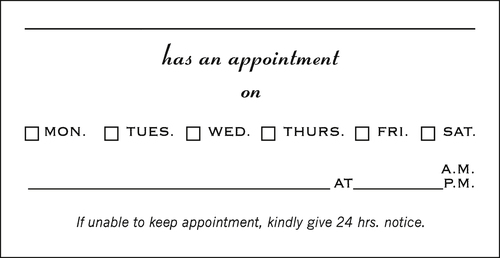
If a surgical procedure has been scheduled, instructions for the pet should be given to the owner. These patients are generally held off food and water before surgery, are dropped off at a specific time, and may be picked up at a specific time. Clients should be given this information in writing to take home; this allows them to review the information in a quiet place (Figure 13-13).
ENTERING APPOINTMENTS
Specific information is needed when making appointments for clients. Obviously, the client’s first and last names are essential. The patient’s name and the reason for the appointment come next, along with a phone number where the client can be reached. Veterinary appointment software automatically populates all the information except for the reason for the appointment when the client’s name is entered. When using a manual appointment book, it may benefit the team to add species, age, and breed of pet. Having all the above information allows the veterinary health care team to prepare for the appointment. Team members know which client will be arriving, what procedure to expect, and what equipment or lab work may be required. This increases the overall efficiency of the team, ultimately leading to a satisfied client.
It is important to have a phone number where the client can be reached on the day of the appointment (as well as a cell phone or pager) in case of an emergency or if questions arise. Veterinarians or team members may get sick or have family emergencies that must be taken care of. Clients will appreciate the phone call notifying them of the delay and may be happy to reschedule their appointment.
Once the appointment information has been completely entered, the team member should read the appointment back to the client, ensuring no miscommunication has occurred. “Mr. Lockridge, we have Rosie scheduled for her yearly exam on Monday, January 21, at 9 am with Dr. Dreamer. Is there anything else I can help you with until we see you on the twenty-first?” is an excellent phrase to use because the date is repeated twice for the client.
UNITS FOR APPOINTMENT SCHEDULE
Many veterinary software applications name time increments as units. When the schedule is set up, the manager assigns a specific time to equal 1 unit. For example, 15 minutes may be classified as one unit. If a regular appointment will only take 15 minutes, then one unit is allotted for that patient. Orthopedic procedures can take 30 minutes and possibly more if radiographs are needed. Therefore this particular appointment would be given 2 units (30 minutes total). This can apply to surgical procedures as well. If a canine neuter takes a team 30 minutes from time of injection to time of extubation, then 2 units would be given for that particular operation. Tumor removals that may require extensive time are given more units. The veterinarian performing the surgery can be asked for a time estimate for the surgery. If the doctor requests 1 hour, then 4 units would be allotted for that operation. By giving time a unit, it is easier to schedule appointments and the efficiency of the staff is increased. It is imperative that the system that is being implemented be easy to understand and user friendly. Figure 13-14 gives examples of units assigned to specific procedures.
CALLING AND REMINDING CLIENTS OF APPOINTMENTS
All clients must be called and reminded of their appointments, regardless of whether it is a surgical or general appointment. Missed appointments represent lost income. Therefore the team should do everything possible to keep missed appointments to a minimum. Many veterinary practices can now send out reminders and updates by email or to pagers and cell phones. Clients appreciate the extra effort that team members are willing to put forth regarding their pets. If a procedure or lab work has been scheduled, this is a perfect time to remind clients of their instructions. Clients who don’t follow instructions fall in the same category as missed appointments; a canceled surgical procedure is lost revenue.
TRAINING NEW EMPLOYEES HOW TO USE THE APPOINTMENT SYSTEM
Once team members have experience at scheduling appointments, making appointments becomes an easy, efficient task. However, scheduling appointments can cause anxiety for new employees. A training program should be implemented to ease this stress and decrease the chance of mistakes. Software systems generally have the usual amount of time allotted for appointments built into the template of the system. However, a list of conditions or diseases and the length of time preferred for related appointments should be made available. A list similar to Figure 13-14 can be created to assist new employees.
A list of clients who need extra time should also be made available to new employees if alerts have not already been added to these clients’ accounts. This will increase the efficiency of the team and add another element to preventing appointments from running behind.
Selecting, managing, and revising an appointment schedule is an intricate but integral part of the veterinary practice. The schedule must be able to meet the needs of the practice, team members, and clients, while balancing productivity and profitability. Studies indicate that clients regard on-time performance to be a more important factor than the practice fee structure. If a patient is going to need further workup, including radiographs or diagnostic tests, it may be advised to leave the patient at the hospital while the workup is being completed. This prevents the client from waiting in the exam room for a prolonged period of time, thereby making other clients wait in the reception area. Clients may also choose to make another appointment for their pets when a workup needs to be completed if they do not wish to leave their pet. It is a common misconception that by meeting the needs of the one client in the exam room and satisfying that client the practice is providing good customer service. Unfortunately, the multiple clients who are waiting are not receiving good customer service. A balance between the two must be developed.
Stay updated, free articles. Join our Telegram channel

Full access? Get Clinical Tree


 PRACTICE POINT
PRACTICE POINT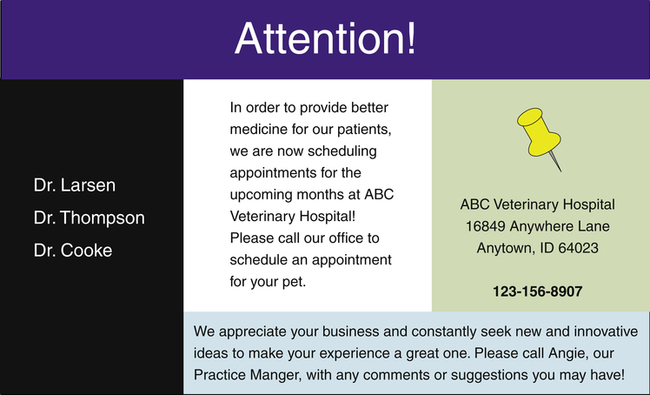
 PRACTICE POINT
PRACTICE POINT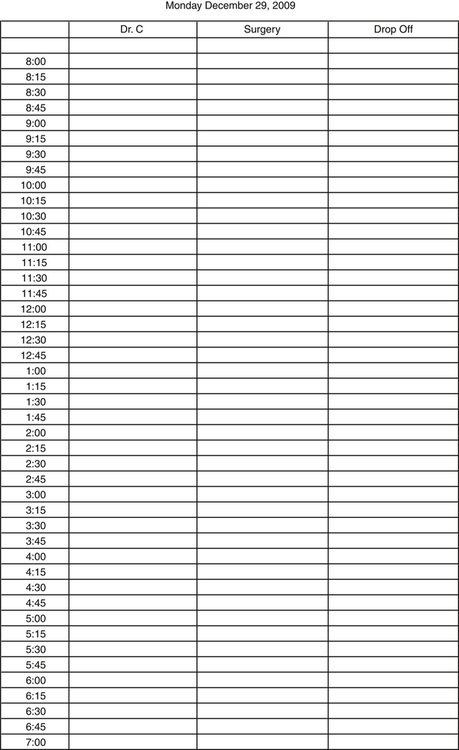
 PRACTICE POINT
PRACTICE POINT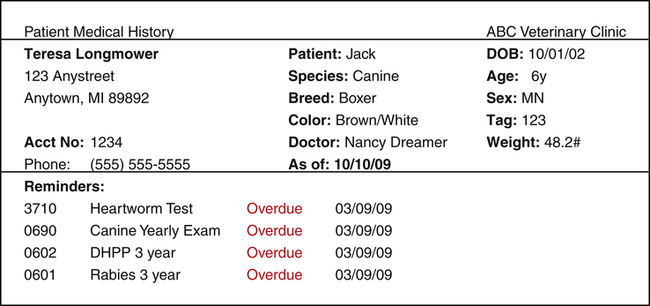
 PRACTICE POINT
PRACTICE POINT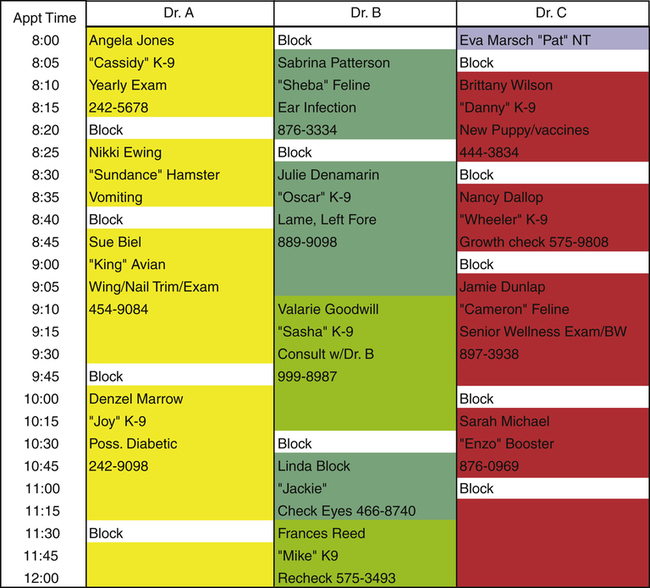
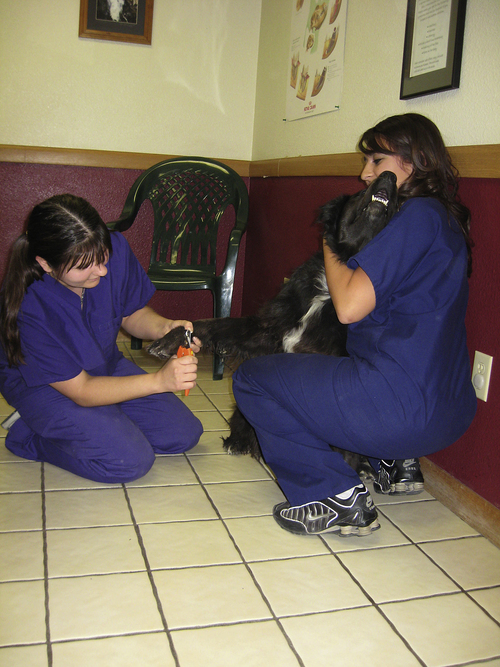
 PRACTICE POINT
PRACTICE POINT PRACTICE POINT
PRACTICE POINT PRACTICE POINT
PRACTICE POINT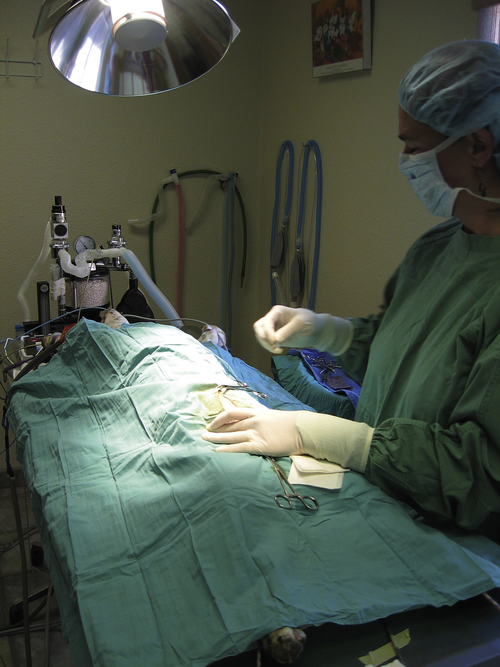
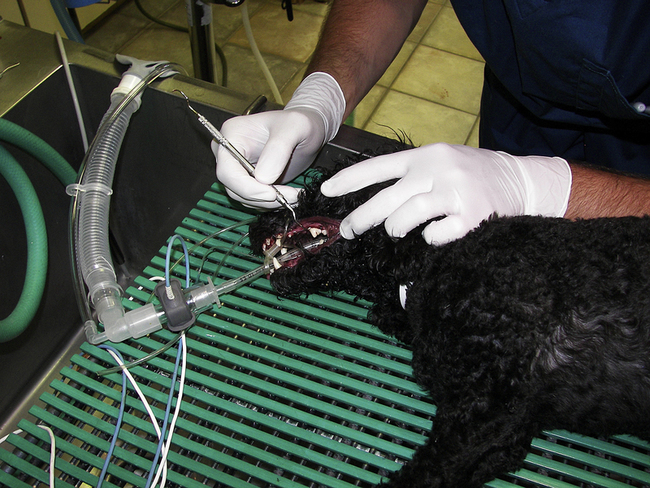
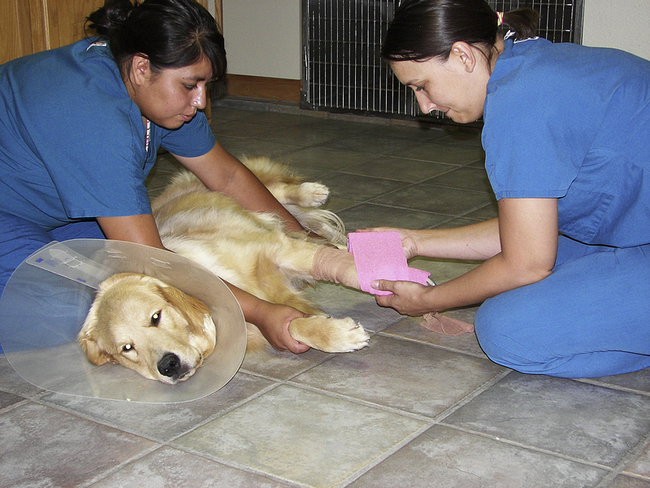
 PRACTICE POINT
PRACTICE POINT PRACTICE POINT
PRACTICE POINT PRACTICE POINT
PRACTICE POINT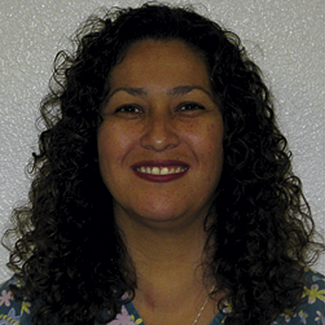 What Would You Do/Not Do?
What Would You Do/Not Do?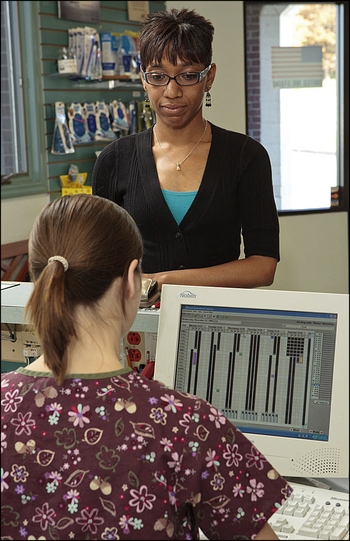
 PRACTICE POINT
PRACTICE POINT PRACTICE POINT
PRACTICE POINT PRACTICE POINT
PRACTICE POINT PRACTICE POINT
PRACTICE POINT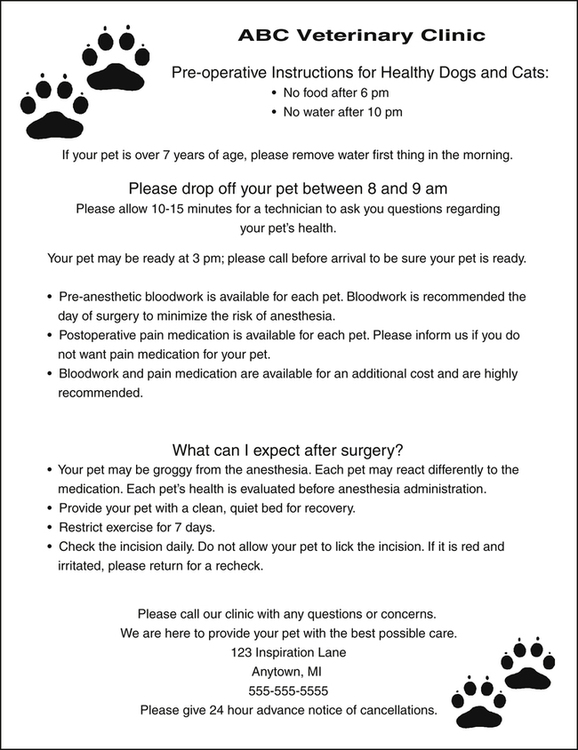
 PRACTICE POINT
PRACTICE POINT PRACTICE POINT
PRACTICE POINT
